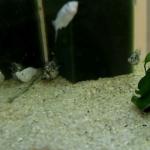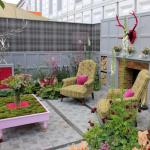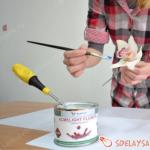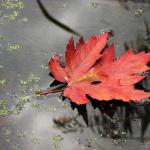Silver Garden
When creating flower beds or compositions from trees and shrubs, we always face a choice: in what color scheme to make them. Some people like combinations of different colors, others like a monochrome garden in white, red or yellow tones, and some garden “gourmets” prefer silver shades.
Why do you need a garden in gray or silver? Is it possible to take as a basis the silver-blue scale for the entire site? In our sunless climate, warm and bright colors are more likely to be lacking than muted, cool tones. If the white garden is a classic, it is created for romantics, for contemplation at dusk, for highlighting shady corners, then the silver garden is suitable for sunny, open areas with well-drained and dry soils. If a garden is created in a Mediterranean style, then it can be all done in gray tones, but sometimes a separate flower garden or composition is made using this color.
In nature and in cultivated plantings, you can often find plants with silvery-gray leaves. We have willow or coltsfoot thickets, sea buckthorn gardens, in a warm climate - olive and cypress groves, lavender fields, rosemary plantings, sedum and milkweed, as well as "gray-haired" tub plants.
It is believed that the silver-blue compositions are intended primarily for creating Mediterranean-style gardens - silver, cheerful and cool. But silver will work in other styles of gardens as well. In regular compositions, symmetrical plantings of blue spruce or clipped hedges in shades of gray are sometimes used. Silver-blue colors are absolutely irreplaceable if your garden is decorated in modern, avant-garde, neoclassical and neo-renaissance styles. The landscape style also allows for the presence of silver in landscape compositions.
When creating a flower garden in the "marine" style, the obligatory symbolic presence of water is implied, which is depicted with the help of silvery, blue, blue, white, gray shades of leaves and flowers. Mixborders of conifers and ornamental-leaf trees and shrubs often include plants with silver-colored leaves and needles. Annual flower beds in any style, especially carpet flower beds, where the pattern is clearly expressed, cannot do without these cold tones. Perennial mixborders, which use a wide variety of brightly colored plant forms, often include silvery-gray shades to balance the composition. They serve as a buffer between poorly matched colors, fill it with light, form poles of tranquility, make other colors richer and richer. In rock gardens and rockeries, silvery tones are often present.
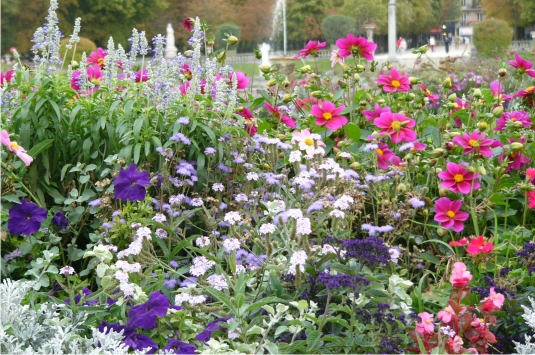
Mixborder with white flowers
The colors white, gray and silver are close in perception - they are neutral and closer to the cold scale, but they always attract attention. Gray color is ambiguous, it has unique properties: it fills the garden with light and visually pushes the boundaries of the garden or mixborder, which is especially important in small gardens. It softens cold colors (cyan, blue) and combines light colors (pink, cream, white, lilac, apricot), and reds, yellows, oranges, purples literally begin to shine in the presence of gray, showing their expressive character. Like white, silver has many shades depending on the environment: it can be yellowish and greenish, pinkish and bluish, “gray” and almost white. Depending on the lighting, weather and the texture of the leaves, it can be sparkling and dull, matte and metallic, cold and warm, modest and elegant, neutral and noble, magical and mysterious. This game of colors will never seem boring and monotonous! Various and correctly selected accessories are extremely important in a silver garden or flower garden: in the form of blue-gray balls, silver moths, benches, supports and obelisks for climbing plants, galvanized, tin and tin containers, garden sculpture.

Ornamental plants in containers
Conifers, trees and shrubs in silver
The assortment of trees and shrubs in silvery colors is quite large. Among coniferous favorites are various types and varieties of spruce: Canadian blue spruce, compact varieties of prickly spruce reaching 1-1.5 m in height, conical spruce, etc. Pines also have shapes with silvery needles: these are Weymouth pine, mountain pine varieties and black. The blue needles of the pea-fruited cypress cultivar "Bulevar" are spectacular, being quite frost-resistant, it requires careful protection from the spring and winter sun. But most of all blue and silver forms can be found among junipers: from tall ones - these are virgin and rocky, from creeping ones - horizontal, recumbent, varieties of Cossack juniper; beautiful blue needles of Chinese juniper and scaly juniper.
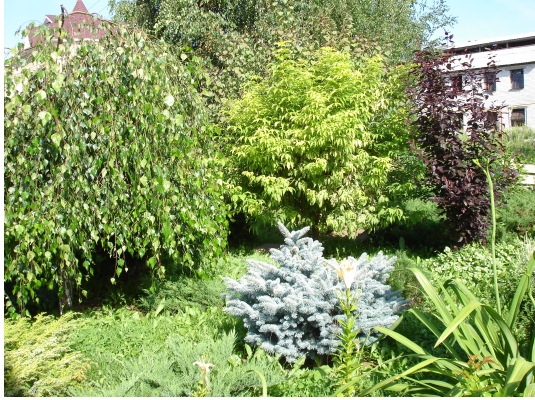
Deciduous trees and shrubs also have many species and varieties with silvery leaves. These are a variety of willows: white, creeping, gray, shaggy.
Sea buckthorn can be used in a garden of the Mediterranean type, as well as willow pear - a tree 5-6 m in height with narrow leaves, powdery mountain ash (round-leaved). Of the shrubs, silver oak and narrow-leaved oak, Canadian rhododendron, Kuril cinquefoil, white snowberry, white-bordered dogwood, some varieties of heather, wild rosemary, andromeda are suitable. Vines have silvery underneath and bluish overhead leaves: honeysuckle, honeysuckle, ash-gray honeysuckle, Albert's honeysuckle.
Blue-gray flowers and herbs
There is a particularly large selection of plants here. Often, annual flower beds and other compositions are complemented by seaside cineraria with its carved blue leaves, which go well with red, yellow, blue flowers. Of the large annuals, the Spanish artichoke, round mordovnik are magnificent. In a substitution culture, silvery petiolate cumin, rosemary, and cypress santolina are used.

Of the bulbous, many species have bluish foliage: muscari, galanthus, bows (Christophe, karatavsky, aftalunsky), as well as liverworts, crested beetles, catchments (most decorative in spring). Among the alpine ground cover plants, there is also a wide variety of silvery forms: rock alyssum, some species rejuvenated (for example, rejuvenated cobweb), Bieberstein's chippings and felt chippings, alpine edelweiss, sedum (bent, Lydian, rocky), alpine aster, open lumbago, etc.
Silver-white flower garden on a green lawn
Medium and tall perennials also contribute to the silvery palette. The wormwood and the Byzantine wormwood with their pubescent leaves, types of wormwood (Louis wormwood, bitter wormwood, Schmidt's wormwood, Steller's wormwood), anaphalis, crown lychnis with purple flowers, giant bluehead, some varieties of garden sage, sage sage (sage sage oakwood, medicinal sage), mountain and blue cornflowers, lavender varieties with delicate purple flowers and an enchanting aroma (requires a sunny place and shelter in winter), stonecrop, xiphoid iris leaves. Some hosta species and varieties have gray-blue foliage and will perfectly complement any flower garden: Hosta Zibodda and Hosta Fortune varieties.
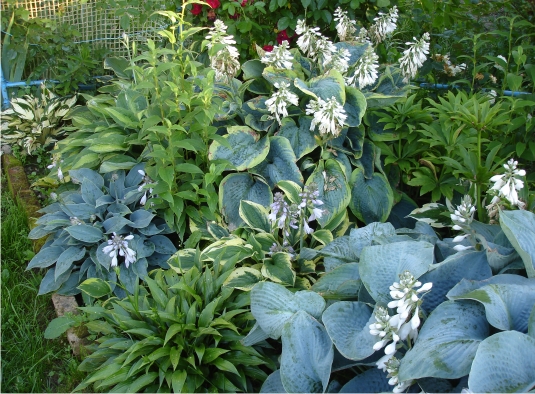
Cereals bring a special charm to any composition, among which there are species with gray-blue foliage.
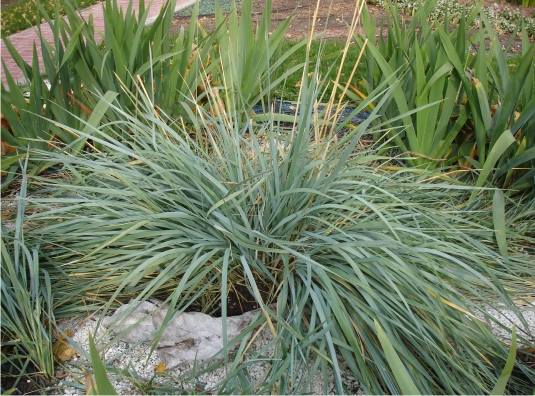
These are gray fescue (forms small clumps), sheep, sandy spikelet and giant spikelet with its wide bluish-gray leaves, falaris (canary reed) with bluish leaves with white stripes.
Text and photo: Natalia Yurtaeva, landscape designer
Gallery:
